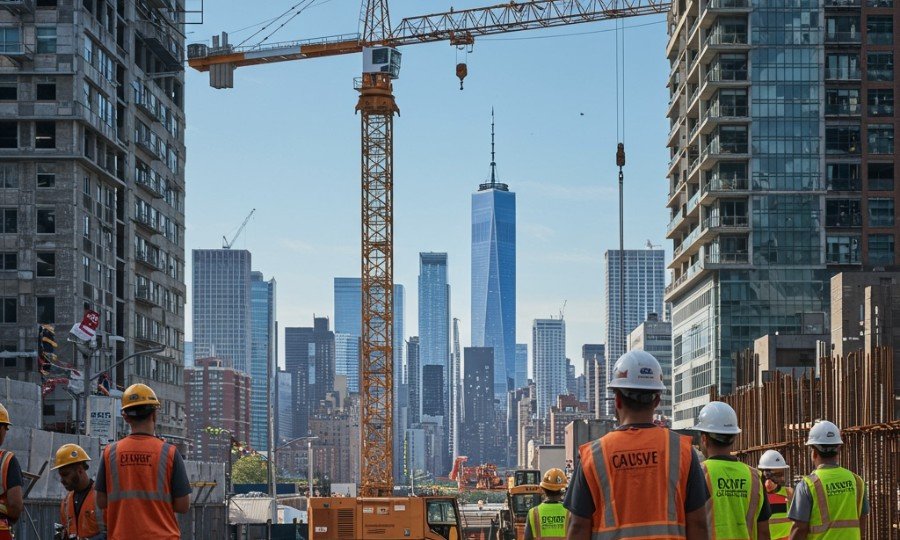
Navigating NYC’s Evolving Construction Safety Regulations: Local Laws and Their Impact
New York City’s skyline is a testament to constant growth and innovation. However, this relentless development brings with it inherent risks, particularly within the bustling construction industry. Ensuring the safety of workers and the public alike is paramount; consequently, NYC regularly updates its regulatory framework to address emerging challenges and improve safety standards. The landscape of construction safety in New York City is not static; indeed, it is continuously evolving through new legislation and increased oversight. Therefore, understanding these changes is not merely a matter of compliance for companies, but a critical aspect of protecting the lives and livelihoods of thousands of workers.
Recent legislative changes and heightened enforcement efforts by the Department of Buildings (DOB) signify a profound commitment to making construction sites safer. These initiatives include pivotal local laws and new enforcement strategies designed to prevent accidents before they occur. For anyone involved in or affected by construction work in NYC, grasping the implications of these regulations is essential. This article will delve into the specifics of Local Law 147, Local Law 196, enhanced oversight for key personnel, and the DOB’s proactive enforcement strategies, ultimately shedding light on their collective impact on safety.
The Foundation of Enhanced Safety: Local Law 196 and Expanded Training
One of the most significant advancements in NYC construction safety is the implementation of Local Law 196. This legislation mandates expanded safety training for workers on construction sites. Prior to this law, training requirements were less comprehensive; however, the city recognized the need for a more robust educational foundation for all personnel. Consequently, Local Law 196 significantly increased the required hours of safety training, ensuring that workers possess a deeper understanding of potential hazards and safe work practices. This includes a Site Safety Training (SST) card requirement, which certifies that individuals have completed the necessary courses, encompassing topics such as fall protection, scaffolding safety, and hazard communication.
The primary purpose of Local Law 196 is straightforward: to reduce construction-related injuries and fatalities through enhanced knowledge and awareness. By requiring more extensive training, the city aims to equip workers with the skills and information necessary to identify and mitigate risks proactively. Furthermore, this law places a greater onus on employers to ensure their workforce is adequately trained and certified. Non-compliance can lead to substantial penalties, underscoring the seriousness with which the city views these training mandates. Ultimately, the expanded training requirements foster a culture of safety where every worker is better prepared to contribute to a secure work environment.
Redefining Oversight: Local Law 147 and ‘Major Buildings’
Another crucial legislative development is Local Law 147, which fundamentally altered the definition of a ‘major building’ in NYC and bolstered site safety requirements. Previously, the definition of a major building was less encompassing. However, Local Law 147 redefines a ‘major building’ as any building that is seven stories or more in height, or 75 feet or more in height. This expanded definition brings a broader range of construction projects under stricter safety oversight. Moreover, it introduces new requirements for these newly defined ‘major buildings,’ specifically mandating the presence of a Site Safety Coordinator or a Site Safety Manager, along with a comprehensive Site Safety Plan.
The introduction of a mandatory Site Safety Coordinator or Manager for these projects signifies a critical step towards increased accountability. These professionals are responsible for overseeing all safety aspects on a construction site, ensuring compliance with regulations, and implementing the site-specific safety plan. In addition, the requirement for a detailed Site Safety Plan means that potential hazards must be identified and addressed systematically before work even begins. This proactive approach aims to minimize risks by design, rather than reacting to incidents after they occur. Therefore, Local Law 147 represents a significant enhancement in how large-scale construction projects are managed for safety, ultimately contributing to a safer environment for workers and the surrounding community.
Bolstering Supervision and Specialized Operations: Superintendents and Crane Operators
Beyond specific local laws, NYC has also intensified its oversight of key personnel crucial to construction safety: construction superintendents and crane operators. Construction superintendents play a vital role in day-to-day site operations and safety management. Consequently, the DOB has implemented stricter requirements and increased scrutiny for these individuals, including enhanced qualifications and responsibilities. These changes aim to ensure that superintendents possess the necessary expertise and authority to maintain a safe work environment, overseeing everything from worker conduct to equipment functionality.
Similarly, crane operations, inherently high-risk activities, have come under renewed regulatory focus. New oversight mandates for crane operators emphasize rigorous training, certification, and strict adherence to operational protocols. Given the catastrophic potential of crane accidents, these enhanced regulations are absolutely critical. For instance, increased inspections of crane equipment and more stringent licensing requirements ensure that only highly qualified and thoroughly vetted individuals operate these complex machines. Clearly, by raising the bar for superintendents and crane operators, the city seeks to minimize human error and ensure that critical safety decisions are made by competent, well-regulated professionals.
Proactive Enforcement and Predictive Analytics: The DOB’s New Approach
The regulatory changes are complemented by a shift in the Department of Buildings’ enforcement philosophy, moving towards a more proactive and data-driven approach. The DOB has significantly increased its inspection rates across construction sites citywide. This heightened presence serves as a deterrent to non-compliance and allows inspectors to identify potential violations before they escalate into serious incidents. Moreover, the increased frequency of inspections means that issues can be addressed more swiftly, preventing prolonged exposure to unsafe conditions.
Perhaps most innovatively, the DOB is planning to launch a new enforcement unit that will utilize predictive analytics. This cutting-edge approach involves analyzing vast amounts of data, including past accident reports, permit applications, inspection results, and even weather patterns, to identify sites with a higher statistical probability of experiencing an accident. By leveraging predictive analytics, the DOB can allocate its inspection resources more efficiently, targeting high-risk sites for focused interventions. For example, if a particular type of work or a specific contractor shows a pattern of violations, the system can flag them for immediate attention. Ultimately, this forward-thinking strategy aims to prevent accidents by anticipating risks, thereby saving lives and preventing injuries before they occur. It marks a significant shift from reactive investigation to proactive prevention.
What These Changes Mean for NYC’s Construction Landscape
The cumulative effect of these evolving regulations is profound, impacting every facet of the NYC construction industry. For workers, these changes generally translate to a safer working environment. They benefit from more extensive training, stricter site oversight, and a greater likelihood of working on sites where safety is prioritized. Nevertheless, workers also bear the responsibility of adhering to these new training mandates and safety protocols.
For employers and contractors, the new regulations necessitate increased investment in training, compliance, and safety infrastructure. While this may entail higher initial costs, the long-term benefits include reduced accident rates, fewer legal liabilities, and a stronger reputation. Moreover, a safer workplace invariably leads to increased productivity and lower insurance premiums over time. Clearly, adherence to these regulations is not just a legal obligation but a sound business practice. The ultimate goal remains the same: to foster a culture where safety is not an afterthought but an integral part of every construction project.
Your Rights and Legal Recourse After a Construction Accident
Despite the city’s best efforts and the implementation of stringent regulations, construction accidents can, unfortunately, still occur. The inherent dangers of the industry mean that even with enhanced training and oversight, unforeseen circumstances or negligent actions can lead to serious injuries or even fatalities. If you or a loved one has been involved in a construction accident in New York City, it is crucial to understand that these regulations exist not only to prevent harm but also to protect your rights.
Navigating the aftermath of a construction accident can be overwhelming, particularly when dealing with severe injuries, lost wages, and complex legal procedures. In such challenging times, having knowledgeable legal counsel is invaluable. Our firm, RMFW Law, stands ready to provide professional, authoritative, and compassionate guidance to victims of construction accidents. We understand the intricacies of New York’s labor laws, workers’ compensation claims, and personal injury litigation. We can help you determine if the new regulations were violated, and how those violations may impact your claim. Consequently, we are dedicated to ensuring that you receive the full compensation you deserve for medical expenses, lost income, pain, and suffering.
You have a right to a safe workplace, and when that right is violated, you have legal recourse. We encourage you to reach out for a confidential consultation. Our experienced attorneys can assess your situation, explain your legal options in clear, direct language, and represent your interests vigorously. Trust us to be your advocates, guiding you through every step of the legal process with unwavering support and expertise. Your well-being is our priority.
Free Case Consultation
Injured in an accident? Contact Rosenberg, Minc, Falkoff & Wolff for a free and confidential case review with an experienced NYC personal injury attorney.
This article was drafted with AI assistance. Please verify all claims and information for accuracy. The content is for informational purposes only and does not constitute professional advice.


